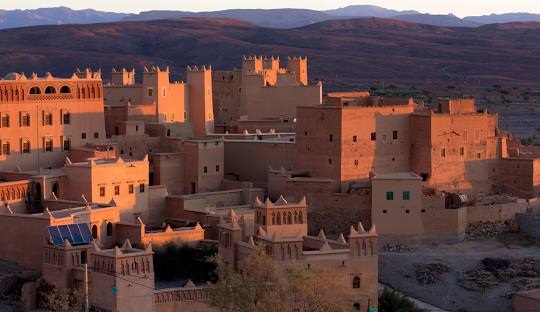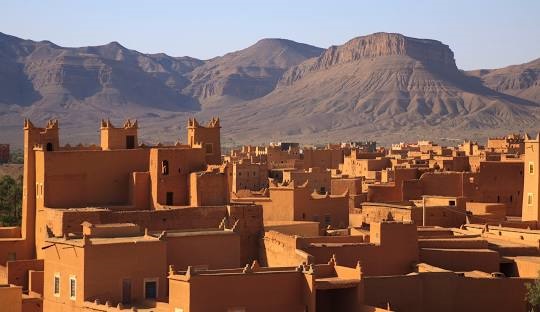Anti Atlas Mountains
The Anti Atlas mountains are located in the southwestern part of Morocco, stretching roughly from the Atlantic coast near the city of Agadir, eastward towards the Sahara Desert. They span a vast area, with their westernmost reaches near the Atlantic Ocean and their eastern terminus blending into the Sahara.
To the north, the Anti Atlas mountains are bordered by the High Atlas Mountains, home to Riad Nkob, while to the south, they give way to the dry, arid regions that transition into the Sahara. This range is part of the larger Atlas Mountain system, which includes the High Atlas, the Middle Atlas, and the Anti-Atlas ranges. The Anti-Atlas still boasts some notable heights, altough being generally lower in elevation compared to the towering peaks of the High Atlas
Jbel Sirwa, one of the most prominent peaks among the Anti Atlas mountains, rises to an elevation of approximately 3,304 meters. It adds to the dramatic landscape of rugged cliffs, deep valleys, and jagged rock formations that characterize the Anti-Atlas region. In fact what makes the Anti Atlas Mountains particularly fascinating is their geological history.
Unlike the relatively younger High Atlas Mountains, the Anti-Atlas range is much older and contains some of the most ancient rock formations in Morocco and even Africa. The origins of the Anti-Atlas can be traced back to the Precambrian era, over 500 million years ago, making it one of the oldest mountain ranges on the continent.
The geological story of the Anti Atlas mountains is tied to the formation and break-up of ancient supercontinents, particularly the Gondwana supercontinent. During the Precambrian, the region that now forms the Anti-Atlas was part of this vast landmass. Over millions of years, tectonic activity, including the collision and separation of continents, shaped the landscape.
The Anti-Atlas was formed as part of the Variscan orogeny, a period of mountain building that occurred roughly 300 million years ago, during the late Paleozoic era, when the African and European plates collided. Today, the Anti-Atlas is a geologist’s paradise, offering a window into Earth’s ancient past. The range is composed of a variety of rock types, including ancient volcanic rocks, sedimentary layers, and metamorphic formations.
Fossils of ancient marine life can also be found, evidence that parts of the Anti-Atlas were once submerged under shallow seas long before the land uplifted to form mountains. The region is also known for its mineral wealth. The Anti Atlas mountains contains significant deposits of minerals such as copper, silver, and lead, which have been mined since ancient times.
In more recent history, the area has attracted interest from geologists and mining companies for its potential to yield valuable resources, particularly in places like the Drâa-Tafilalet region. The climate of the Anti-Atlas varies depending on the location and elevation, but it is generally characterized by a dry, semi-arid to arid climate.
The western part of the Anti Atlas mountains, closer to the Atlantic coast, benefits from some maritime influence, which brings slightly more moisture and milder temperatures. However, as one moves eastward and into the heart of the range, the climate becomes increasingly dry, with hot summers and cold winters.
Rainfall in the Anti-Atlas is generally low, and much of the region is classified as desert or semi-desert. However, the higher elevations of the mountains receive more precipitation, particularly in the winter months, when snow can fall on the peaks. Despite the harsh, dry conditions, the Anti-Atlas supports a surprising diversity of plant and animal life, particularly in areas where water is available, such as in the oases and valleys that dot the region.
Vegetation in the Anti Atlas mountains includes a mix of drought-resistant shrubs, grasses, and trees. The argan tree, native to southwestern Morocco, is one of the most iconic plants of the region. It thrives in the semi-arid conditions and is an important source of livelihood for local communities, as its fruit is used to produce argan oil, a valuable commodity both locally and internationally.
In the more arid areas, vegetation becomes sparser, with hardy plants like acacias and cacti dominating the landscape. Wildlife in the Anti-Atlas includes a variety of reptiles, birds, and small mammals that have adapted to the region’s harsh conditions, being home to species like the Barbary ground squirrel, the fennec fox, and various species of lizards.
Birdwatchers are also drawn to the Anti Atlas mountains for their diverse birdlife, which includes raptors like the Bonelli’s eagle and migratory species that pass through the region on their journeys between Europe and Africa. The Anti-Atlas is not only significant for its geological and environmental features but also for its rich cultural history. The region is home to the Amazigh people, one of the oldest ethnic groups in North Africa.
The Berbers have lived in the Anti-Atlas and surrounding regions for thousands of years, maintaining a distinct cultural identity that is reflected in their language, traditions, and way of life. The Berber communities in the Anti-Atlas are known for their deep connection to the land. They have traditionally been semi-nomadic, relying on agriculture and livestock herding in the fertile valleys and oases that dot the mountains.
Terraced fields are a common sight in the Anti Atlas mountains, where Berbers grow crops such as barley, wheat, and olives, using ancient irrigation techniques to make the most of the limited water supply. One of the most notable aspects of Berber culture in the Anti-Atlas is their distinctive architecture. The region is dotted with traditional fortified villages and homes, many of which are built from locally sourced materials like mud brick and stone.
These structures are often perched on hilltops or nestled in valleys, blending seamlessly with the surrounding landscape. The fortified villages and homes are not only functional but also reflect the ingenuity and resilience of the Berber people in adapting to their environment. The Anti-Atlas region is also known for its vibrant traditions of craftsmanship and art.
Berber artisans of the Anti Atlas mountains are skilled in a wide range of crafts, including weaving, pottery, and metalwork. Carpets, known for their bold geometric patterns and bright colors, are highly prized and often made by hand in small villages. Jewelry-making is another important craft in the region, with silver being the most commonly used material.
Berber jewelry is known for its intricate designs, often incorporating symbolic motifs that reflect the region’s cultural and spiritual heritage. In recent years, the Anti Atlas mountains have become an increasingly popular destination for tourists seeking adventure, natural beauty, and a glimpse into Morocco’s rich cultural heritage.
The Anti Atlas mountains offer a range of activities, from trekking and hiking in the rugged area to exploring ancient villages and interacting with the local Berber communities. One of the most popular destinations in the Anti-Atlas is the town of Tafraoute, located in the heart of the range, and known for its stunning pink granite boulders, which create a surreal and otherworldly landscape.
The town is a hub for hiking and trekking, with numerous trails leading into the surrounding mountains and valleys. Visitors can explore the unique rock formations, ancient rock art, and traditional Berber villages that dot the area. Another highlight of the Anti Atlas mountains is the Ameln Valley, located near Tafraoute. This picturesque valley is home to several small Berber villages, each with its own distinct character.
The valley is known for its almond trees, which bloom in the spring, creating a breathtaking sea of pink and white blossoms. The Ameln Valley is also a popular spot for hiking, with trails that offer stunning views of the surrounding mountains. For those interested in history and archaeology, the Anti Atlas mountains are home to several ancient sites, including rock carvings and petroglyphs that date back thousands of years.
These carvings provide a glimpse into the lives of the early inhabitants of the region and are an important part of Morocco’s cultural heritage. The Anti Atlas mountains are a region of great natural beauty, geological significance, and cultural richness. This ancient mountain range, with its rugged landscapes, diverse ecosystems, and deep connection to the Berber people, offers a unique and fascinating destination for travelers and scholars alike.



